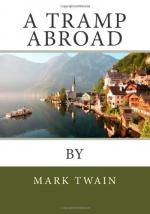I had always had a deep and reverent compassion for the sufferings of the “prisoner of Chillon,” whose story Byron had told in such moving verse; so I took the steamer and made pilgrimage to the dungeons of the Castle of Chillon, to see the place where poor Bonnivard endured his dreary captivity three hundred years ago. I am glad I did that, for it took away some of the pain I was feeling on the prisoner’s account. His dungeon was a nice, cool, roomy place, and I cannot see why he should have been dissatisfied with it. If he had been imprisoned in a St. Nicholas private dwelling, where the fertilizer prevails, and the goat sleeps with the guest, and the chickens roost on him and the cow comes in and bothers him when he wants to muse, it would have been another matter altogether; but he surely could not have had a very cheerless time of it in that pretty dungeon. It has romantic window-slits that let in generous bars of light, and it has tall, noble columns, carved apparently from the living rock; and what is more, they are written all over with thousands of names; some of them—like Byron’s and Victor Hugo’s—of the first celebrity. Why didn’t he amuse himself reading these names? Then there are the couriers and tourists—swarms of them every day—what was to hinder him from having a good time with them? I think Bonnivard’s sufferings have been overrated.
Next, we took the train and went to Martigny, on the way to Mont Blanc. Next morning we started, about eight o’clock, on foot. We had plenty of company, in the way of wagon-loads and mule-loads of tourists—and dust. This scattering procession of travelers was perhaps a mile long. The road was uphill—interminable uphill—and tolerably steep. The weather was blisteringly hot, and the man or woman who had to sit on a creeping mule, or in a crawling wagon, and broil in the beating sun, was an object to be pitied. We could dodge among the bushes, and have the relief of shade, but those people could not. They paid for a conveyance, and to get their money’s worth they rode.
We went by the way of the Te^te Noir, and after we reached high ground there was no lack of fine scenery. In one place the road was tunneled through a shoulder of the mountain; from there one looked down into a gorge with a rushing torrent in it, and on every hand was a charming view of rocky buttresses and wooded heights. There was a liberal allowance of pretty waterfalls, too, on the Te^te Noir route.
About half an hour before we reached the village of Argentie`re a vast dome of snow with the sun blazing on it drifted into view and framed itself in a strong V-shaped gateway of the mountains, and we recognized Mont Blanc, the “monarch of the Alps.” With every step, after that, this stately dome rose higher and higher into the blue sky, and at last seemed to occupy the zenith.




